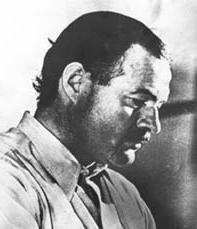The writing style of
Ernest Hemingway
Ernest Hemingway
1899-1961
American novelist and journalist, known for his economical and understated style, and works like 'The Old Man and the Sea' and 'A Farewell to Arms'.
Ernest Hemingway’s writing style is as distinctive as his adventurous life and as impactful as his stories. A Nobel laureate, Hemingway’s approach to prose is often described through his adherence to the “Iceberg Theory,” a technique that demands the writer omit anything superfluous, leaving the deeper meaning of the text to be implicitly understood by the reader. This method results in writing that is lean, direct, and devoid of the ornate flourishes that characterized much of the literature that preceded him.
Hemingway’s sentences are notoriously short and simple but powerful, with a rhythmic quality that mirrors the action it describes. This simplicity is deceptive; behind the straightforward surface lies a complex understanding of human nature and emotion. Hemingway achieves this depth through his masterful use of dialogue—a tool that lets the characters’ words speak for themselves without overt authorial intrusion. His dialogue often carries the weight of the narrative, pushing the plot forward and deepening character development, all while maintaining a veneer of simplicity.
The choice of words in Hemingway’s work is meticulously deliberate. He favored concrete nouns and active verbs, eschewing the passive voice and excessive adjectives. This precision not only contributes to the clarity of his prose but also intensifies the scenes he depicts. The sensory details are never lavish but always sufficient to anchor the reader in Hemingway’s vividly real worlds.
Hemingway’s narrative structure also reflects his distinctive style. He often jumps into scenes without preamble, a technique that places readers immediately into the action and demands their active engagement. The structure of his stories is such that each sentence and scene is essential, with nothing to spare. This economy of language is perhaps Hemingway’s most defining characteristic, influencing countless writers in the generations that followed.
Through these techniques, Hemingway’s writing remains a paragon of modernist literature, demonstrating that profound complexity can lie beneath deceptively simple surfaces.
